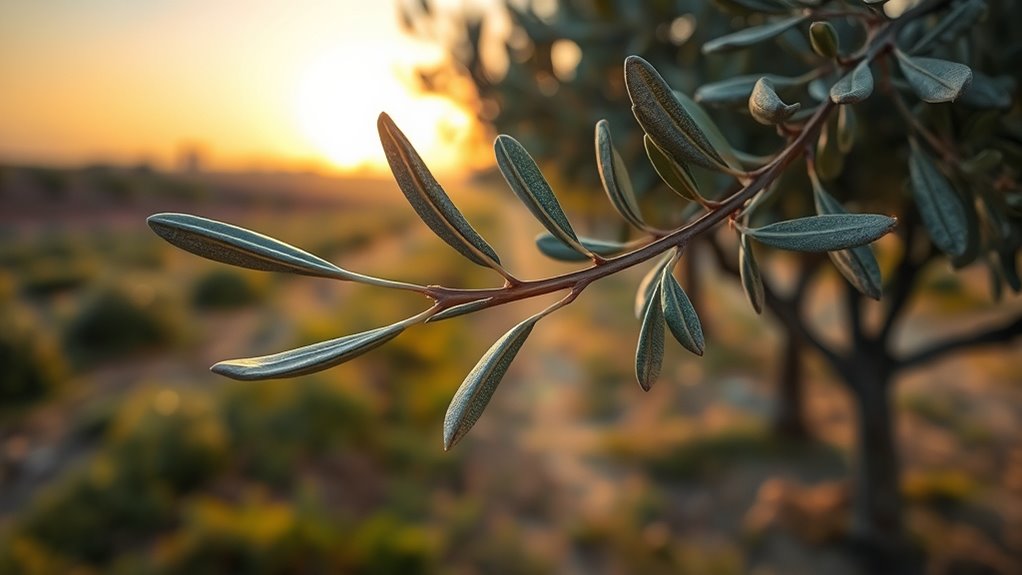The olive branch has symbolized peace and reconciliation since ancient times, rooted in Greek customs and mythology. It was used to crown victors, signal hope, and offer a truce during conflicts, embodying wisdom and divine favor. Over centuries, this symbol spread globally, remaining a powerful sign of harmony across cultures. Its ongoing significance reflects humanity’s hopes for peace, and exploring its history reveals how this simple gesture evolved into a universal emblem of reconciliation.
Key Takeaways
- The olive branch originated as a symbol of peace and victory in ancient Greece, intertwined with divine and cultural significance.
- It was used historically to signal reconciliation, especially by offering it during conflicts to restore harmony.
- The biblical story of Noah’s dove with an olive leaf reinforced its association with hope and forgiveness across cultures.
- Over time, the olive branch evolved into a universal emblem of peace, appearing in religious, diplomatic, and national symbols worldwide.
- Today, it continues to represent the universal desire for harmony, embodying centuries of cultural and spiritual traditions promoting peace.

The olive branch has long symbolized peace and reconciliation, but its evolution reveals a complex history rooted in ancient traditions and cultural significance. When you consider the symbolism of the olive, you’re tapping into a rich tapestry that stretches back thousands of years. In ancient Greece, the olive tree was intertwined with the goddess Athena, representing wisdom, prosperity, and victory. The act of offering an olive branch became a universal gesture of peace, stemming from this deep-rooted tradition. Historically, the significance of the olive extended beyond mythology; it was a crucial resource for early civilizations, providing food, oil, and medicinal properties. This practical importance elevated the olive’s status, embedding it into the cultural and spiritual fabric of societies around the Mediterranean.
The olive symbolizes peace, wisdom, and victory, with roots in ancient traditions and cultural significance across civilizations.
When you look at ancient texts and archaeological finds, you’ll see that the olive’s role in history isn’t just symbolic but also tangible. For example, in the Olympic Games, victors were crowned with olive wreaths, signifying not only victory but also honor and divine favor. Such practices underscore the olive’s importance as a symbol of achievement and peace alike. During times of conflict, offering an olive branch wasn’t merely a peaceful gesture but also a strategic act rooted in the cultural understanding of the olive’s sacredness and value. It conveyed a desire to end hostilities and restore harmony, leveraging the olive’s symbolism of renewal and hope. Cultural Significance of the olive further deepens its role as a universal emblem of peace.
As history progressed, the meaning of the olive branch persisted but expanded beyond the ancient world. In Christian tradition, the olive branch became a symbol of divine approval and reconciliation, especially after the biblical story of Noah’s Ark, where a dove returns with an olive leaf, signaling the end of the flood and the promise of peace. This story helped cement the olive branch as an enduring emblem of hope and forgiveness in Western culture. Today, you see this symbolism used globally—on flags, in diplomatic gestures, and in cultural expressions—reminding us of the olive’s deep-rooted significance in fostering peace.
Understanding the historical significance of the olive helps you appreciate why the olive branch remains a powerful symbol today. It’s not just a simple gesture but a centuries-old tradition that encapsulates humanity’s longing for harmony, rooted in the shared history of civilizations that revered the olive for its practical and spiritual value. From ancient rituals to modern diplomacy, the evolution of the olive branch continues to reflect our collective aspiration for peace, making it a timeless emblem of reconciliation across cultures and eras.
Frequently Asked Questions
How Did the Olive Branch Become a Universal Symbol of Peace?
You might wonder how the olive branch became the universal symbol of peace. Its roots lie in olive branch mythology, where it represented reconciliation and hope. Over time, its symbolic evolution solidified as a sign of truce and harmony, especially in Western culture. Today, you see it worldwide as a powerful emblem, reminding you of peace and the possibility of reconciliation after conflict.
What Are Some Historic Conflicts Where the Olive Branch Was Prominently Used?
Imagine a fragile olive branch, reaching across battle-scarred lands. You see it in Ancient Greece, where envoys offered peace amidst chaos. Later, Roman diplomacy clutched this symbol, signaling truce and reconciliation. These historic conflicts used the olive branch not just as a gesture, but as a powerful promise of peace. Its steady presence reminds you that even in war, hope can sprout from a simple, peaceful gesture.
Are There Cultural Variations in the Symbolism of the Olive Branch?
You’ll find that cultural variations influence how the olive branch symbolizes peace. In some cultures, it appears in rituals or religious ceremonies, representing hope and reconciliation. Artistic representations often reflect these diverse meanings, emphasizing harmony or forgiveness. You might notice differences in colors, gestures, or accompanying symbols, all shaped by unique cultural rituals that give the olive branch its rich, multifaceted significance worldwide.
How Has the Olive Branch Been Used in Modern Peace Negotiations?
Think of the olive branch as a bridge spanning conflict and harmony. In modern peace negotiations, you see it as a powerful diplomatic gesture symbolizing hope and reconciliation. Leaders often exchange olive branches during peace treaties, signaling their willingness to move past disputes. These gestures help build trust and open dialogue, turning ancient symbols into real tools for peace in today’s complex diplomatic landscape.
What Are the Ecological Impacts of Cultivating Olive Trees for Peace Symbolism?
You might not realize it, but cultivating olive trees for peace symbolism impacts ecology considerably. Your efforts in sustainable farming help reduce environmental harm, while promoting biodiversity preservation. Olive orchards can support diverse species and improve soil health. However, large-scale planting may lead to habitat disruption if not managed properly. By balancing cultivation with eco-friendly practices, you can uphold the olive branch’s peaceful symbolism while protecting ecological health.
Conclusion
As you reflect on the journey from war to peace, the olive branch stands as a timeless symbol of hope and reconciliation. It reminds you that even in the darkest moments, a symbol of peace can bloom anew, whispering that conflict is not the end, but a chapter in a larger story of understanding. Like a gentle dove, the olive branch invites you to believe in the possibility of harmony—if only you choose to extend it.











